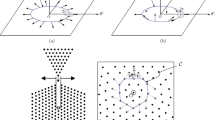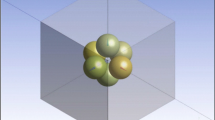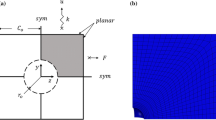Abstract
The work is motivated by inadequacy of the conventional defect density parameters, such as porosity (relative volume of pores) or the usual crack density in situations that are frequently encountered in applications: of non-spherical pores of diverse shapes, fluid-filled cracks/pores, pores in an anisotropic matrix. We call a defect density parameter proper if it correctly reflects the individual defect contributions into the effective elastic properties. Only in terms of such parameters can these properties be uniquely expressed. Their identification is non-trivial even in the framework of the non-interaction approximation; defect interactions further complicate the problem. We show that the proper parameters are identified by the structure of the elastic potential. Besides being necessary, the proper parameters yield the following benefits:
(1) anisotropy due to non-randomly oriented defects is established;
(2) expressions for the effective moduli cover, in a unified way, all mixtures of defects of diverse shapes and arbitrary orientational distributions;
(3) they provide guidance for the proper interpretation of experimental data on elasticity of porous materials.
For certain types of defects (field of pores of complex, but identical shapes, for example), the general results in terms of tensorial parameters reduce, for each particular orientational distribution, to expressions in terms of the conventional parameters. However, in other situations (non-spherical pores of diverse shapes, fluid-filled cracks/pores, pores in an anisotropic matrix) such a reduction cannot, generally, be done, even for a particular orientational distribution.
Similar content being viewed by others
References
Bristow, J.R. (1960). Microcracks and the static and dynamic elastic constants of annealed and heavily cold-worked metals. British Journal of Applied Physics 11, 81–85.
Budiansky, B. and O'Connell, R.J. (1976). Elastic moduli of a cracked solid. International Journal of Solids and Structures 12, 81–97.
Carvalho, F. and Labuz, J. (1996). Experiments on effective elastic modulus of two-dimensional solids with cracks and holes. International Journal of Solids and Structures 33(28), 4119–4130.
Eshelby, J.D. (1957). The determination of the elastic field of an ellipsoidal inclusion and related problems. Proceedings of the Royal Society A241(1226), 376–396.
Hasselman, D.P.H. (1962). On porosity dependence of the elastic moduli of polycrystalline refractory materials. Journal of the American Ceramics Society 45(9), 452–453.
Hill, R. (1963). Elastic properties of reinforced solids: some theoretical principles. Journal of the Mechanics and Physics of Solids 11, 357–372.
Horii, H. and Nemat-Nasser, S. (1983). Overall moduli of solids with microcracks: load-induced anisotropy. Journal of the Mechanics and Physics of Solids 31/2, 155–171.
Jasiuk, I., Chen, J. and Thorpe, M.F. (1994). Elastic moduli of two-dimensional materials with polygonal and elliptical holes. Applied Mechanics Reviews 47(1), S18-S28.
Kachanov, M. (1980). Continuum model of medium with cracks. Journal of Engineering Mechanics Division 106(EM5), 1039–1051.
Kachanov, M. (1982). Microcrack model of rock inelasticity. Part I: frictional sliding on pre-existing microcracks. Mechanics of Materials 1, 19–27.
Kachanov, M. (1987). Elastic solids with many cracks: a simple method of analysis. International Journal of Solids and Structures 23, 23–43.
Kachanov, M. (1992). Effective elastic properties of cracked solids: critical review of some basic concepts. Applied Mechanics Reviews 45(8), 304–335.
Kachanov, M. (1993). Elastic solids with many cracks and related problems. In: Advances in Applied Mechanics 30 (Hutchinson, J.W. and Wu, T.Y., eds), Academic Press, 259–445.
Kachanov, M. (1995). On the concept of approximate elastic symmetry and its application to materials with defects. International Journal of Fracture 74, R33-R38.
Kachanov, M., Tsukrov, I. and Shafiro, B. (1994). Effective properties of solids with cavities of various shapes. Applied Mechanics Reviews, 47(1), 151–174.
Kanaun, S.K. and Levin, V.M. (1993). Effective field method in the mechanics of composite materials. Petrozavodsk University (in Russian), 600 p.
Krivoglaz, M. and Cherevko, A. (1959). On the elastic moduli of a two-phase solid. The Physics of Metals and Metallography, Pergamon Press, 8(2), 1–4.
Mackenzie, J.K. (1950). Elastic constants of a solid containing spherical holes. Proceedings of Physical Society (London) 63B(1), 2–11.
Mauge, C. and Kachanov, M. (1994). Effective elastic properties of anisotropic materials with arbitrarily oriented cracks. Journal of the Mechanics and Physics of Solids 42, 1–24.
Piau, M. (1980). Crack-induced anisotropy and scattering in stressed rocks. International Journal of Engineering Science 18, 549–568.
Sayers, C. and Kachanov, M. (1995). Microcrack-induced elastic wave anisotropy of brittle rock. Journal of Geophysical Research 100(B3), 4149–4156.
Shafiro, B. and Kachanov, M. (1997). Materials with fluid-filled pores of various shapes: effective elastic properties and fluid pressure polarization. International Journal of Solids and Structures 34, 3517–3540.
Shafiro, B. and Kachanov, M. (1998). Solids with non-spherical cavities: simplified representations of cavity compliance tensors and the overall anisotropy. Journal of the Mechanics and Physics of Solids, in press.
Spriggs, R.M. (1961). Expression for effect of porosity on elastic modulus of polycrystalline refractory materials, particularly aluminum oxide. Journal of the American Ceramics Society 44(12), 628–629.
Talreja, R. (1985). A continuum mechanics characterization of damage in composite materials. Proceedings of the Royal Society, London A399, 195–216.
Thorpe, M.F. and Sen, P.N. (1985). Elastic moduli of two-dimensional composite continua with elliptical inclusions. Journal of the Acoustical Society of America 77(5), 1674–1680.
Tsukrov, I. and Kachanov, M. (1993). Solids with holes of irregular shapes: effective moduli and anisotropy. International Journal of Fracture 64, R9–12.
Tsukrov, I. and Kachanov, M. (1998). Effective moduli of an anisotropic material with arbitrarily oriented elliptical holes, to be published.
Vakulenko, A. and Kachanov, M. (1971). Continuum theory of medium with cracks. Mechanics of Solids 6(4), 145–151, Plenum Publ. Co. (English transl. of Izvestia AN SSSR, Mekhanika Tverdogo Tela).
Vavakin, A.S. and Salganik, R.L. (1975). Effective characteristics of nonhomogeneous media with isolated inhomogeneities. Izv. ANSSSR, Mekhanika Tverdogo Tela 10, 65–75 (in Russian); English transl.: Mechanics of Solids, Allerton Press, 58–66.
Walsh, J.B. (1965a). The effect of cracks on the compressibility of rocks. Journal of Geophysical Research 70(2), 381–389.
Walsh, J.B. (1965b). The effect of cracks on uniaxial compression of rocks. Journal of Geophysical Research 70(2), 399–411.
Willis, J.R. (1977). Bounds and self-consistent estimates for the overall moduli of anisotropic composites. Journal of the Mechanics and Physics of Solids 25, 185–202.
Wu, S. and Chudnovsky, A. (1990). The effective elastic properties of a linear elastic solid with microcracks. Engineering Fracture Mechanics 37(3), 653–659.
Zhao, Y.H., Tandon, G.P. and Weng, G.J. (1989). Elastic moduli for a class of porous materials, Acta Mechanica 76, 105–130.
Zimmerman, R.W. (1985). Compressibility of an isolated spheroidal cavity in an isotropic elastic medium. Journal of Applied Mechanics 52, 606–608.
Zimmerman, R.W. (1986). Compressibility of two-dimensional cavities of various shapes. Journal of Applied Mechanics 53, 500–504.
Author information
Authors and Affiliations
Rights and permissions
About this article
Cite this article
Kachanov, M. Solids with cracks and non-spherical pores: proper parameters of defect density and effective elastic properties. International Journal of Fracture 97, 1–32 (1999). https://doi.org/10.1023/A:1018345702490
Issue Date:
DOI: https://doi.org/10.1023/A:1018345702490




